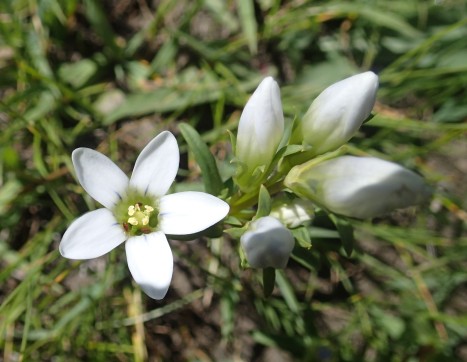It’s three months since I’ve had time to write a blog and term has ended so it feels like time for something indulgent about some of my favourite plants, which I’ve seen in locations as disparate as northern India, Bulgaria and the Durham coast over the last couple of years.
The Plant List names nearly 1700 accepted species in the plant family Gentianaceae, divided between 96 genera. The family, and the ‘type’ genus, Gentiana, are named after the Illyrian king Gentius, who ruled the western Balkans around 180 BC. Apparently, he was amongst the first to suggest that the large yellow Gentiana lutea, common in the mountains of central and southern Europe, had medicinal properties. What we do know for sure is that the roots of G. lutea contain a glycoside called Amarogentin, one of the most bitter natural compounds known. This was used in brewing, along with other bitter herbs, before the cultivation of hops and is still used in the production of a spirit called Gentian, one component of that key cocktail ingredient, Angostura bitters!
Gentianaceae are found in temperate regions all round the world, though in the UK we tend to think of them as mountain plants. Living in Durham, one of my favourites has to be our county flower the spring gentian, Gentiana verna. Although a common alpine meadow plant in other parts of Europe and Asia, in England G. verna is found only in upper Teesdale – a survivor from the period after the end of the last ice age when the land was colonised by an Artic-alpine flora. It’s always a special treat to hunt it out in bright May sunshine when the short turf is studded with tiny azure flowers, open wide to tempt the early bees which pollinate them.

Spring gentian, Gentiana verna, Upper Teesdale
Autumn gentians are another, if less dramatic, local delight later in the season. My local nature reserve, Bishop Middleham quarry, sports a good population of these.

Autumn gentian (Gentianella amarella)
Much spreading and diversification of the gentian family took place during the Eocene epoch, between 56 and 33.9 million years ago – the family includes trees, shrubs and herbs of all sizes. So, what do these plants have in common? All have actinomorphic or radially-symmetrical hermaphrodite flowers, with the petals fused together at the base to form a corolla-tube. The sepals too are fused into a calyx-tube at the base. The number of stamens matches the number of lobes on the corolla (petals) and the stamens are attached to the throat of the corolla tube.
Left: Gentiana leucomelaena from Ladakh, showing five-fold radial symmetry of corolla lobes and stamens. Right: Gentianopsis paludosa, by Tso Moriri, Ladakh, with its four petals fused into a corolla-tube and sepals fused into a calyx-tube
Different genera within the Gentianaceae have slightly different flower structures. In Gentiana species, there are little scales known as plicae between the main lobes, but not in Gentianella species.
Gentiana carinata (left) and Gentianella moorcroftiana (right) Kashmir
Many gentians have fringes of hairs or fimbriae where the petals join to form the corolla-tube, detaining insects attracted to the nectaries for a little longer to improve the chances of pollen being transferred between plants.

Gentianella bulgarica, Pirin mountains, Bulgaria
In Comastoma species these hairs form dense crowns over the flower’s female parts.
Comastoma pedunculatum, Kashmir and Ladakh
Some gentians don’t look quite so typical. We found two tiny, gentian relatives, Halenia elliptica and Swertia ciliata growing in and around the Valley of Flowers last summer.
Halenia elliptica (left) and Swertia ciliata (right)
Halenia gets its common name (Spurred gentian), from the long horns projecting from each of its four petals, whilst the purple band around the base of the Swertia petals makes them look, to me, like miniature passion flowers.
Gentian relatives closer to home are equally diverse, including both Centaury and Yellow-wort as well as the Autumn gentian.
Seaside centaury (Centaurium littorale) left and Yellow-wort (Blackstonia perfoliata) right
Centaury has the five-fold symmetry typical of so many gentians but Yellow-wort has up to eight-lobed flowers. Both plants, along with the spring and autumn gentians favour the calcareous grasslands and sand dunes abundant in NE England. Most of the gentians in Bulgaria favoured similar habitats, though we found Gentiana asclepiadea growing in woodland above Rila.

Gentiana asclepiadea, Rila mountains, Bulgaria
For sheer impact, though, my best ever gentian haul has to be our lunch stop en route to Tso Moriri in Ladakh last summer. Roll on next summer’s trip to the Himalayas….










where can i get dried flower of himalayan gentian?
I don’t really know. What do you want them for and which species?
Currently in Mayrhofen, Austria where on mountain walks we have seen different types of gentian. However 2 are puzzling us as they both seem to be called willow gentian, gentiana asclepiadea, but one has a drooping form to the plant and is similar to your photo above but with deeper blue flowers. The other is an upright plant in which each pair of opposite leaves are at right angles to the pair above or below. The flowers appeared similar on each form and we saw numerous examples of each type with the drooping form being seen in more shady wooded areas. My husband ‘identified’ both as Willow Gentian – Gentiana asclepiadea- using the Seek app on his phone. Any light you can shed on whether these are two different species would be appreciated. Photos available if you let me have an address to send them to. We are here from Cumbria visiting our daughter.
Hi Sandra, I’m not an expert on European gentians but happy to have a look at photos if you send them to h.a.kelly@durham.ac.uk 🙂